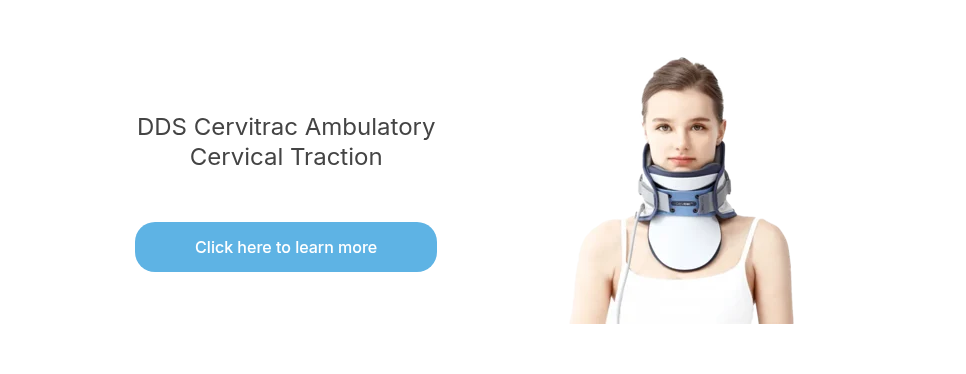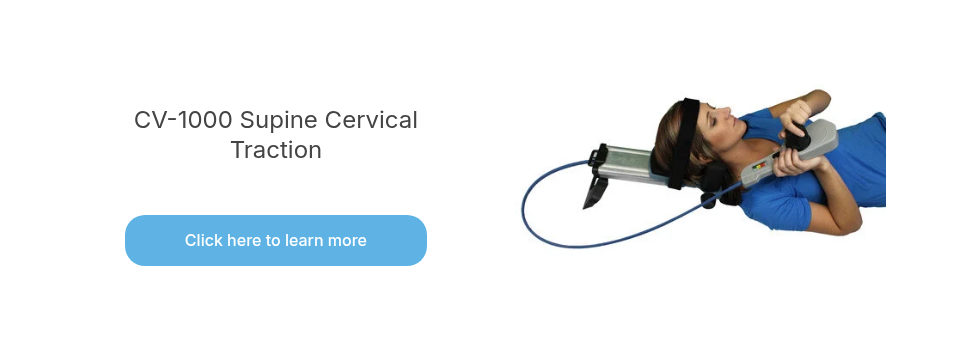How To Safely Use Cervical Traction At Home
Cervical traction is a treatment method that has gained attention for its potential benefits in relieving painful neck conditions. This guide aims to provide you with a comprehensive understanding of cervical traction, its benefits, and how to apply it safely at home.
In this blog article we will review the safe use of supine and ambulatory cervical traction at home treatments.
What is Cervical Traction?
Cervical traction is a non-invasive treatment that involves applying gentle pressure to the neck to improve circulation and reduce muscle tension. The intervertebral disc space is increased during traction which reduces pressure. Cervical traction therapy can be applied while standing (Ambulatory) or while laying down (Supine).
Whether you're working from home, recovering from an injury, or simply looking to relieve chronic neck discomfort, cervical traction therapy can be beneficial when used appropriately. Discuss any pre-existing conditions with your healthcare provider to determine if cervical traction may be unsafe. While cervical traction is generally a safe treatment with minimal risks, you should discuss your health history before starting treatment.
You can learn more about how to discuss your pain and preparing for a visit with your healthcare provider in these blog articles.
How to Talk to Your Doctor About Your Pain
Tips for Communicating With Your Doctor at Your Next Appointment
Typical Indications for Use
The following are common conditions that can be treated with cervical traction.
- Herniated or compressed discs
- Degenerative disc disease
- Radiculopathy
- Osteoarthritis
- Spinal stenosis
- Muscle spasms
- Pain and headaches due to soft tissue stiffness
The use of at home cervical traction to treat a condition diagnosed by your healthcare provider should always follow the prescribed treatment plan.
Diagnosis and Treatment
Diagnosis:
Usually involves physical examination, medical history review, and sometimes imaging tests such as an X-ray or MRI if needed. These tests will help your healthcare provider determine if cervical traction is an appropriate treatment for your condition.
Treatment Options:
It is important to always follow the prescribed treatment plan prescribed by your healthcare provider. Your healthcare provider will provide recommendations for treatment duration and frequency. The use of ambulatory or supine cervical traction may be recommended based on your injury or the condition being treated.
Safe use of a medical device that applies cervical traction is found in the patient instructions provided by the manufacturer. The instructions describe how to apply the device, adjust the amount of traction, and remove it when the therapy is complete.
Ambulatory Cervical Traction:
Ambulatory cervical traction is applied while sitting or standing. A medical device is applied to the neck which adjusts to apply the desired amount of traction. It’s ideal for those with a desk job or anyone needing relief from chronic neck pain while having the freedom to move around during treatment.
Supine Cervical Traction:
Supine cervical traction is applied while laying down. A medical device that cradles your neck and secures the head is used to apply gentle pressure to separate the cervical spine. This method is particularly useful after minor injuries like whiplash or for individuals who find it challenging to move around due to chronic pain.
Heat Therapy:
Applying heat therapy to the neck before performing a cervical traction treatment can help loosen tight muscles and improve circulation. Try applying moist heat to the neck for 10-15 minutes before beginning a cervical traction treatment. The heat can make cervical traction more comfortable and improve fluid circulation.
When to Seek Medical Help
If painful or debilitating symptoms persist or worsen despite self-care measures, it’s important to consult a healthcare provider. They can offer personalized advice or recommend further evaluation if necessary.
Conclusion
Cervical traction therapy is a versatile home treatment option that can enhance comfort and reduce neck-related discomfort. Whether ambulatory or supine, these methods provide effective relief when used correctly. Always consult with a healthcare professional to determine the best approach for individual needs, ensuring safe and effective use of these therapies.
We're Here To Help
The team of experts at Elite Medical Supply of NY is here to help identify the right cervical traction device for your recovery. We also offer a wide selection of braces from world-class manufacturers to alleviate pain and help heal your condition. Take a look at our selection of braces by clicking here.
When you're ready to order a product or need assistance making a choice we're here to help. You can reach us at 866-712-0881, send us an email, or fill out a contact form.
Written by Elite Medical Supply of NY
Braces and Products Covered by Medicare
Browse ProductsRecent Posts
Topics
- Back Braces (38)
- Knee Braces (31)
- Medicare Beneficiaries (31)
- Pain (24)
- Non-Opioid (22)
- Medical Providers (19)
- Product Highlight (11)
- Lower back pain (10)
- Sciatica (10)
- Muscle Spasms (8)
- Decompression (7)
- Lumbago (7)
- Degenerative disc disease (6)
- Lumbar Spinal Stenosis (6)
- Spinal Stenosis (6)
- Working with your doctor (6)
- Fracture healing (5)
- Bulging or herniated disc (4)
- Herniated Nucleus Pulposus (4)
- SI Joint (4)
- Spondylolysis (4)
- Wrist Pain (4)
- Bone Growth Stimulator Therapy (3)
- Bone Growth Stimulators (3)
- Carpal Tunnel Syndrome (3)
- Neuromuscular Electrical Stimulation (NMES) (3)
- Quadratus Lumborum Syndrome (3)
- SI Joint Dysfunction (3)
- Unicompartmental Osteoarthritis (OA) (3)
- Wrist Brace (3)
- wrist tendinitis (3)
- Braces for Golf (2)
- Electrical Stimulation (2)
- Failed Spinal Fusion Syndrome (2)
- Kyphosis (2)
- Lumbar compression fractures (2)
- Spondylolisthesis (2)
- Total Knee Replacement (2)
- Wrist Braces (2)
- Ambulatory Cervical Traction (1)
- Arthritis (1)
- Braces for skiing (1)
- Cervical Traction (1)
- De Quervain Syndrome (1)
- Digital DME Orders (1)
- Knee Brace Accessory (1)
- Knee Suspension Wrap (1)
- Knee brace support for skiing (1)
- Medicare Scam (1)
- Muscle Atrophy (1)
- PCL (1)
- Patellofemoral Pain Syndrome (1)
- Radiculopathy (1)
- Supine Cervical Traction (1)
- TLSO (1)
- Ulnar Tendinitis (1)


